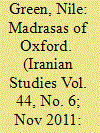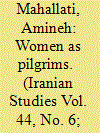| Srl | Item |
| 1 |
ID:
108479


|
|
|
|
|
| Publication |
2011.
|
| Summary/Abstract |
Young people play an important role in shaping Iran's politics but have only a marginal role in its economy. Youth (ages 15-29) are more than one-third of the country's population and are better educated than the generation they are replacing, while accounting for more than two-thirds of the unemployed. Demographics have thrown the marriage market out of balance, with a "shortage of men" of about 25 percent, while economic pressures have reduced the ability of youth to get married and form families. The higher education system has expanded to absorb ever greater numbers of youth but because education quality is low this has not helped in reducing unemployment. The demographic pressures have amplified since 2008 when the economy entered a period of stagnation. The economic crisis has hit Iran's youth particularly hard, especially those from lower economic backgrounds because the country's rigid formal labor market preserves jobs for older workers. The record number of youth entering the labor market has to wait longer for a regular job or has to take up part-time and informal jobs. In either case, their difficulties in marriage and family formation are intensified.
|
|
|
|
|
|
|
|
|
|
|
|
|
|
|
|
| 2 |
ID:
108485


|
|
|
|
|
| Publication |
2011.
|
| Summary/Abstract |
Since the late 1980s, Iran has pursued a policy of attracting foreign investment and fostering regional trade by granting favored status to the so-called "Free Trade-Industrial Zones" (FTZs) and "Special Economic Zones" (SEZs). To date six FTZs and sixteen SEZs have been set up throughout Iran. The FTZs are strategically positioned for their potential international links and have their eyes on markets beyond Iran, and the SEZs for their value in serving main industries and for improving the country's distribution system and supply network. This paper examines the experience of these zones in Iran in the context of Iran's contradictory and ambivalent approach to international economic integration in general. It is shown that liberal policies pursued in the free zones have been in marked contrast to the approach in the mainland, which has been generally inward-looking in much of the post-revolutionary period. We examine first the rise of free zones as a global phenomenon followed by an overview of Iran's zones and their characteristics. It is argued that serving mainly as "back doors" to the international economy, Iran's free zones have stalled mainly because their promotion has been decoupled from, if not at odds with, official attitudes to the international economy at large. As a result, the zones' ability to attract investment has been limited by both adverse external perceptions of Iran as an investment destination and internal complexities discouraging such investment.
|
|
|
|
|
|
|
|
|
|
|
|
|
|
|
|
| 3 |
ID:
108481


|
|
|
| 4 |
ID:
108487


|
|
|
|
|
| Publication |
2011.
|
| Summary/Abstract |
Shiraz's importance as a Buyid political capitol during the late Buyid period has been mentioned but not thoroughly analyzed. This article attempts to understand Shirazi politics under the late Buyid Abu Kalijar (r. 415/1024 to 440AH/1048CE) by tracing the careers of three prominent figures in his court: the Ismaili propagandist Al-Mu'ayyad fi al-Din al-Shirazi, the Sunni Qadi Abdallah al-Fazari, and Abu Kalijar's Wazir Bahram ibn Mafanna al-'Adil. Using material from a variety of different narrative sources, it becomes clear that all three individuals used their understanding of court politics and their connections to one or more factions, preferably military factions, to gain sufficient intimacy with King Abu Kalijar to present their own point of view and to exclude other individuals from doing the same. Abu Kalijar was able to maintain sufficient contact with a variety of different factions to prevent the kind of factional warfare that was evident in Baghdad in the same period. By tracing the political strategies of these three men, the article sketches the structure of Shirazi politics and highlights the inclusiveness of Abu Kalijar's court and its relative stability compared to the Baghdad court of the same period.
|
|
|
|
|
|
|
|
|
|
|
|
|
|
|
|
| 5 |
ID:
108488


|
|
|
| 6 |
ID:
108482


|
|
|
|
|
| Publication |
2011.
|
| Summary/Abstract |
A hitherto neglected aspect of the Iranian women's lives and activities is their traveling and travelogues. A number of Iranian women pilgrims to Mecca and the Shi'ite holy shrines of Mesopotamia during the past four centuries have left behind memoirs of their travels. They recorded interesting details about their spiritual experience as pilgrims to the holy lands of Islam and of the difficulties of the journey, especially the notoriously dangerous land route from Iran to Mecca through the Arabian Desert. This paper examines four examples of that genre, the oldest dating from the early eighteenth and the other three from the late nineteenth centuries. As expected, the authors were all members of upper class families: one was a princess, another a former queen, and the other two were also affiliated with the ruling families in one way or another. However, they shared the same goals with all other female, and male, pilgrims: to perform their Muslim religious duty of hajj and to do it right. They all wrote about their spiritual satisfaction but also of the disadvantages and the extra burden that a woman experienced in her pilgrimage journey, simply for being a woman.
|
|
|
|
|
|
|
|
|
|
|
|
|
|
|
|